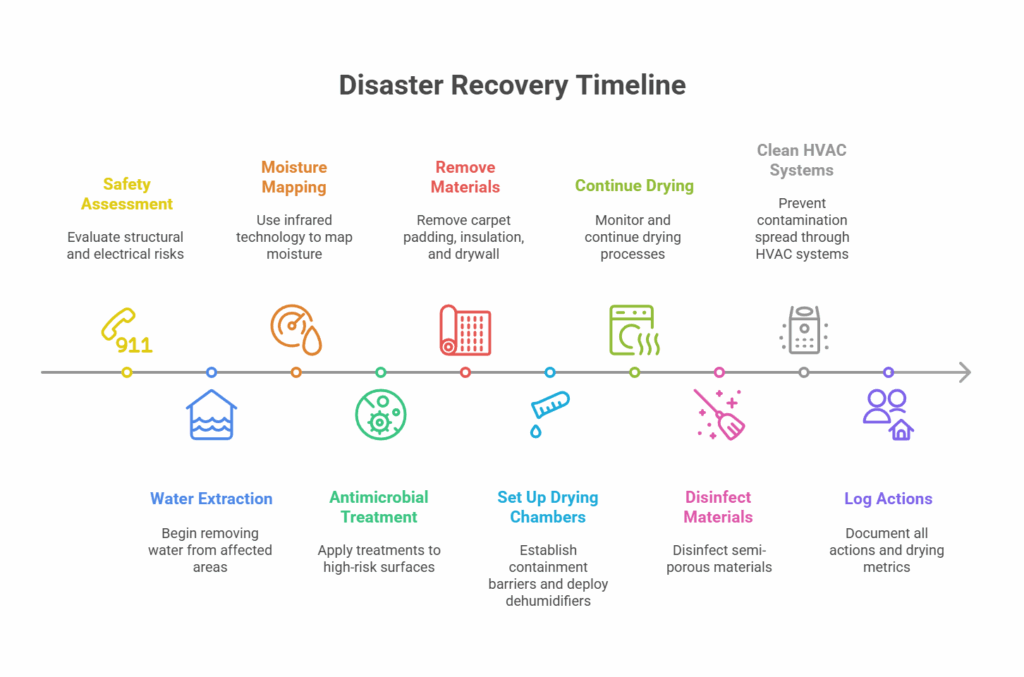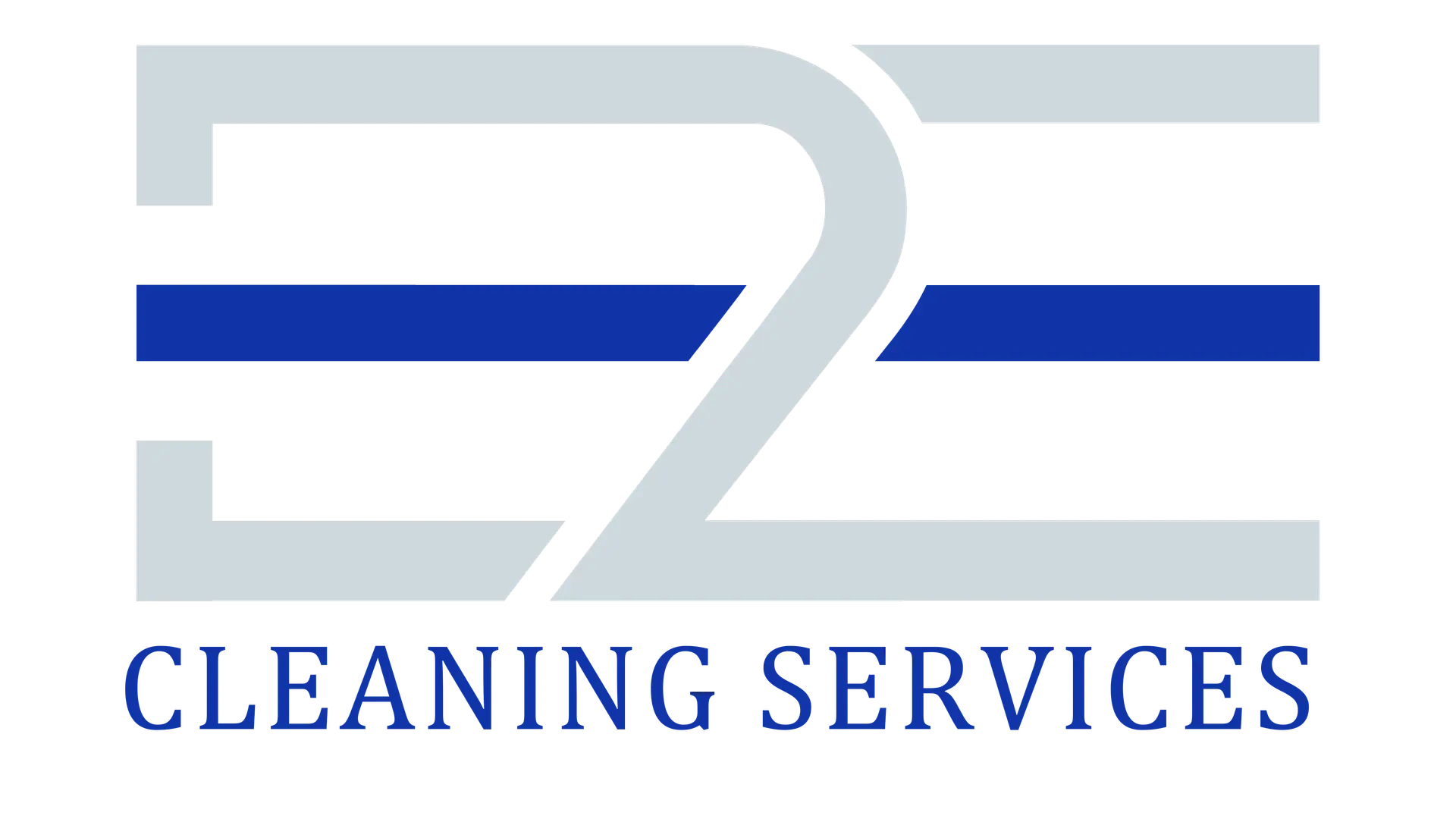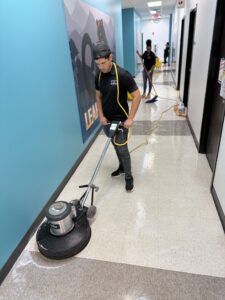When disaster hits your Florida business, you have just 24-48 hours before water becomes irreversible. With 1.5 hurricanes and over 3,000 floods events hitting Florida each year, emergency preparedness is not an option, it is a matter of business survival.
Whether you are in Miami Beach under a storm surge or inland Orlando under flash floods, or anywhere in between preparing for Florida’s weather risks, this guide reveals the emergency cleaning strategies that spell the difference between life and death of your business.
These evidence based recommendations can help businesses in the region to minimize downtime, protect assets and ensure continuity following hurricanes, floods and other emergencies that are common in the region.
The Critical Nature of Emergency Response Planning in Florida
Florida’s businesses are unlike any other. The challenge for corporations is when the average is 1.5 hurricanes and 3,000 flood events per year, the risk and the threat of disruption is constant.
FEMA says that 40% of small businesses never reopen after a disaster. Another 25% will close down within a year. The financial hit? Around $8,000 per hour in lost revenue. Water damage cleanup alone costs $3.75 per square foot.
The climate has gotten a yearly treat to businesses. Within 24–48 hours after water exposure, mold can grow. Typically, temperatures over 90°F accelerate bacteria growth. Saltwater damage corrodes equipment and infrastructure quickly at coastal properties.
In this environment, emergency cleaning services are not a luxury, they are a strategic move.
Florida’s emergency framework comprises local Emergency Operations Centers, the State Emergency Response Team (SERT), and private cleaning specialists. It is important to know how to coordinate these resources in building a strong emergency plan.
The process explained in this guide will help you protect your own assets and maintain business continuity.
Professional flood damage cleanup. Prevents long-term structural issues and mold growth
Emergency Preparedness: Building Resilience Before Disaster Strikes
A good emergency plan is one that is started long before a storm hits. In Florida, that means dealing with your property’s specific risks and accessing Florida’s strong emergency response network.
Any plan’s backbone is a thorough Emergency Response Plan (ERP) centered on cleaning and restoration. Your ERP should lead into detailed systems of critical series: electrical panels, data server rooms, chemical storage, and important documents and files. Keep schematics of shut off valves, drainage points and flood containment zones off site.
According to the Institute for Business and Home Safety, businesses with detailed, practiced ERPs recover on average 61% faster.
Pre-Disaster Partnerships Matter
Never wait until a storm is on its way to vet a cleaning provider.
Find companies that that are IICRC and RIA certified and especially those that are:
- S500 (water damage) and S520 (mold remediation) certifications
- Documented emergency response times
- Large-scale recovery equipment
- Certified staff in biohazard and disaster restoration
- Full insurance and Florida licensing
- Experience with such local hazards as saltwater, mold and hurricane debris
Stock the Right Supplies
Always keep key supplies on site to jump start recovery.
- High-capacity water extractors (25–50 gallons per minute)
- Industrial dehumidifiers (30+ gallons daily capacity)
- Antimicrobial agents for common Florida molds
- Personal protective gear for first responders
Train Like It’s Real
Conduct quarterly drills on the first 60 minutes post-disaster. The biggest impact on recovery speed is that window.
Training should include:
- Insurance-ready documentation procedures: Photos can be used for pre-event and damage assessment. The value realized from these assets includes logs of remediation steps, materials, and treated areas, among others.
- Environmental readings: (humidity, air quality, temperature)
Backups Save Businesses
Form mutual aid agreements with other similar businesses in other regions. By forging these partnerships it can lend to an emergency resource that offers temporary operational space, and shared access to equipment when disaster strikes locally.
Understanding Response Timelines: The Science of Disaster Recovery
It is a race against the clock to emergency clean. Science, not guesswork, determines recovery timelines, and knowing what happens when puts you in action mode, the right one.

The Golden Hours: First 24–48 Hours
This is the most critical window after water intrusion. Structural materials absorb moisture fast:
- Drywall: 1.5 inches in the first hour, up to 6 inches in 24
- Plywood: starts to delaminate within 12–24 hours.
- Bacterial growth: It accelerates exponentially after 72 hours and bacterial growth occurs.
Florida’s humidity (over 80% often) accelerates this process even more. Timing matters.
Typical Emergency Cleaning Timeline
1-4 Hours Post-Event:
- Safety assessment: structure, electrical, sewage risks
- Start water extraction—basements and foundations first
- I clearly discuss moisture mapping with infrared tech.
- High risk surfaces should be treated with antimicrobial treatments.
4-24 Hours Post-Event:
Remove carpet padding, insulation and drywall.
- Containment barriers should be set up in drying chambers
- Commercial dehumidifiers (desiccant or refrigerant) can be deployed.
- Contains HEPA air filtration to keep mold spores and particles.
24-72 Hours Post-Event:
Continue to dry and check for moisture
- Disinfect semi-porous materials
- Prevent spread of contamination through clean HVAC systems
- Log all actions and drying metrics for insurance.
Different Disasters, Different Timelines
Flooding and debris make quite a combination:
- Hurricanes: entail cleanup on multiple tracks
- Fires: Involve toxic smoke residues and longer odor remediation
- Biohazards: Like sewage backflow—require higher-grade PPE and extended disinfection
Set Expectations with Your Cleaning Provider
Communication is key. Ensure they commit to:
- A situation report within 60 minutes of arrival
- Daily updates on progress and moisture readings
- Photos, thermal scans, mapping, etc. are all covered in full.
- Updates to clear scope if hidden damage is found
During regional disasters, Florida’s emergency response network focuses on hospitals and critical infrastructure. That usually means delays for commercial buildings unless you have a pre-existing relationship with a certified provider.
Planning ahead guarantees your business is one of the first on the list when every second
Service Expectations During Emergency Cleaning: Standards and Deliverables
The good thing when hiring emergency cleaning services in Florida is that you can allocate the resources the right way and avoid being surprised by costly things during the recovery.
The ANSI/IICRC S500 Standard for Water Damage Restoration should be followed by professional water damage cleanup. Protocols for cleaning differ depending on the type of water.
Category 1 (Clean Water):
This type of water requires standard disinfection using quaternary ammonium sanitizers. There is a minimal protective equipment needed and the process can take around 60 minutes to complete.
Category 2 (Gray Water):
Gray Water can contains harmful contaminants. Technicians must wear enhanced protective equipment and use EPA-approved disinfectants that kill bacteria and fungi.
Warning: In Florida’s heat, this type of water can deteriorate to severe contamination within 48-72 hours.
Category 3 (Black Water):
Generally, caused by hurricanes and floods. Requires sealed extraction equipment and hospital-grade disinfectants. Porous materials often need removal. Full protective equipment including respiratory protection is mandatory.
Expect These Service Standards
Professional cleaning providers should document:
- Target moisture levels before and after drying (under 16% wood moisture equivalent)
- Humidity and temperature tracking throughout
- Confirmation of disinfection by ATP testing
- Air particle counts, especially post-mold remediation
Service Levels to Know
Most providers offer tiered packages:
- Emergency Response Only: Immediate water removal, debris cleanup, and basic disinfection. It stabilizes the situation, however, it does not include any repairs.
- Complete Restoration: Includes drying, demo of nonsalvageable parts, antimicrobial treatments, and minor reconstruction (affordable drywall or flooring), etc.
- Turnkey Recovery: All the services involved in cleanup, rebuild, permit handling and code compliance. Higher cost, but faster return to business.
Cost Breakdown in Florida
The prices are based on the level of contamination, the materials and the urgency.
Typical ranges:
- Water extraction: $3.50–$7.00/sq. ft.
- Drying equipment: $1,200–$3,600/day
- Antimicrobials: $0.30–$0.60/sq. ft.
- Content cleaning: 15–40% of replacement cost
The Role of Insurance Coordination
Documentation is key in Florida’s complex insurance market. Top-tier providers have insurance specialists assigned for:
- Thermal cameras for moisture mapping
- Digital psychrometric charts to follow drying.
- Photo logs of damaged materials
- Chain of custody for regulated waste disposal
Moving unaffected inventory and documenting initial damage can be done by your staff. However, they should not be allowed to enter contaminated areas or to dry without proper training and equipment.
Disaster Recovery: Implementing Business Continuity Strategies
The emergency cleaning is just the beginning. Real recovery in general view comprises running the operation, keep the money coming in and preserving the customer trust.
Zone-Based Restoration Strategy
The best way to do this is to restore your facility in phases, starting with what’s most important.
Phase 1: Critical Operations
Fast get back to business by focusing on areas of higher importance.
- Retail: POS systems and limited inventory areas
- Manufacturing: Key production lines
- Offices: Server rooms, customer service stations.
These areas can get rapid cleaning with minimum disruption, sometimes with temporary containment to allow operations to continue while deeper restoration carries on nearby.
Phase 2: Secondary Functions
Next, recover support areas like admin offices, storage, and break rooms.
These spaces are usually 3–7 days after Phase 1 to give more time for detailed remediation without interrupting operations.
Phase 3: Full Facility Restoration
It addresses all remaining affected areas usually together with reconstruction.
The facility may temporarily shift operations within the facility to allow for more intensive cleaning.
Phase 4: Preventive Upgrades
Long range improvements will build in resilience to your property.
- Moisture-resistant materials
- Better drainage
- Critical systems are placed at elevated levels.
Mold Prevention in Florida’s Climate
Mold prevention is of utmost importance in Florida due to the humidity.
Recovery plans should include:
- Humidity and temperature monitoring
- Fungistatic coatings during rebuild
- Industrial-grade dehumidifiers
- Volume Negative Pressure Containment to prevent cross-contamination of other patients.
Financial Recovery Resources for Florida Businesses
There are available helpful programs which offers aids for business who are facing a disaster aftermath and for those businesses located in declared disaster zones.
Such as:
- Florida Small Business Emergency Bridge Loans is a short-term recovery funding
- SBA Disaster Loans Which offers low-interest funding
There are also Tax Relief Programs in place after emergency official declarations.
Post-Incident Review: Turning Response Into Resilience
Review your emergency procedures after recovery. Therefore, top-tier providers can provide data-driven analysis, such as:
- Response time benchmarks
- Moisture control effectiveness
- Material durability under exposure
- Performance of staff during the crisis
These insights also aid you to improve your future preparedness. Florida’s leading businesses annually revisit their cleaning and recovery protocols, even if their own sites were not affected, but learnt from recent disasters.
Conclusion: Building a Resilient Florida Business
Florida’s climate, coastline and hurricane risk requires more than standard emergency cleaning. It needs to be a proactive, precise, and tailored to local challenge focusing always on a recovery plan.
These strategies among advance planning, selecting trusted providers, implementing phased recovery, and establishing clear timelines form the foundations of long-term resilience business.
Five Actions to Take Now
- Develop site specific emergency cleaning protocols that take into account Florida’s climate risks.
- Be teamed up with certified restoration providers with the expertise in the storm and flood recovery.
- Create sturdy documentatin systems to ease up the cleanup process and settling insurance claims.
- Train your team for first-response action in safe and effective ways that match the profession of services.
- Zone based recovery model is adapted to prioritize first key partition of operations and reducing downtime for system and backed up data.
These steps when implemented by businesses can lead to a recovery of up to 60% faster with minimal disruption and damage in the long term.
Plan Ahead. Save More.
Each one dollar spent on preparedness will save $4 to $7 lost revenues and recovery costs. Thus, emergency cleaning is not just a reactive fix, but a core business sustainability strategy.
Prepare today, thrive tomorrow.






